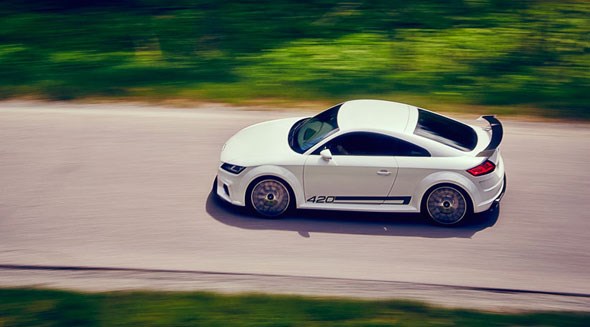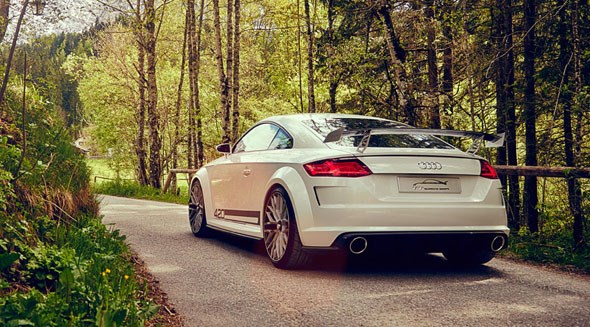So this is the first drive of the new 2015 Audi TT. Yes, it’s the Audi TT 420 Quattro Sport concept car – the very car in fact that wowed the Geneva motor show in March and almost overshadowed the debut of the production TT. But this isn’t some cobbled together one-off, it’s the real thing, fitted with a prototype 414bhp version of the 2.0-litre TFSI engine most TTs will be powered by. So we’d better take it seriously.
That’s not hard when you look at it – the full-le-n-g-t-h 420 stickers (that’s 420ps, which equals 414bhp), the tall tailgate spoiler, menacing carbonfibre bodykit and alcantara-trimmed bucket seats all scream performance intent. The space beneath the tailgate is occupied by a partial roll cage and by two scoops designed to cradle a brace of racing helmets, there are no rear seats, and most of the cabin is clad in an ultra-thin moleskin-type material which scores 10/10 for looks and 1/10 for noise insulation. It’s easy to imagine that the next TT RS will feel something like this.
Click here for more on the Audi TT 420 Quattro Sport concept car.
Driving the new 2015 Audi TT
Firing up the engine is an event. Hit the red button on the helm to awaken the starter which requires two or three snarling revolutions to crank up the highly tuned 2.0-litre four. Once again, the production car lapses back into concept car mode. Idle speed is revving up and down the tone ladder in 200rpm waves; the water pump, the oil pump and the injection pump take a few moments to synchronise their a capella performance; you can almost feel the lubricant swarming out to the remote corners of the powerplant which duly changes its tone of voice from high-pitched metallic to a healthy baritone.
Playing with the throttle introduces the two key sparring partners to this quattrophonic ring: the intake plenum and its broadband coloratura, and the dual-stage exhaust system which oscillates between mass murmur and raw roar. When you shift down on the move with the left index finger, the chips will automatically blip the throttle; when you give her stick and keep the right foot firmly planted, a phonetic explosion marks the transition from bawl to blare at 4500rpm; when you change up one gear close to the redline and then another, the four sounds almost like a five, and then very briefly even like a six.
Although the TT420 may have what it takes to evolve into the next TT RS, it won’t feature this engine. Instead, the top-of-the-line version will run Audi’s five-cylinder unit, which gets a new lease of life in the shape of a seriously modified alloy-block motor (good for 525bhp in the latest S3-based hot concept).
‘We had to beat the Golf R’
The TTS will remain loyal to the 2.0-litre TFSI, which is featured by every mainstream VW Group brand. Originally pegged at 292bhp, TTS output has recently been lifted to 306bhp. How come? Because Ulrich Hackenberg, now Audi’s r&d supremo, felt an urge to eclipse the 296bhp Golf R. For exactly the same reason, the output of this hot TT420 concept was increased to a lofty 414bhp – 20bhp more than the 394bhp Golf R400 concept. Talk about inter-brand one-upmanship. Although it is the most powerful 2.0-litre petrol engine, this particular iteration is not currently confirmed for production.
The TT420 is redlined at 7200rpm, and the turbocharged 16-valver produces peak power at 6700rpm. The maximum torque of 332lb ft is spread over an uncommonly wide rev band from 2400 to 6300rpm. With four-wheel drive and a tidy 1344kg kerbweight, 0-62mph takes just 3.7sec. Like the engines of the Lamborghini Huracan and the race-winning Audi R8, the third-generation 2.0-litre four (EA888) features a mix of direct and indirect injection systems for maximum mid-range grunt, impressive high-end urge, quick low-end response and strong overall efficiency.
Other engineering highlights include the variable valve lift system, adjustable intake and exhaust camshafts, lightweight pistons with integrated cooling ducts, a forged steel crankshaft and a mixed-flow turbocharger operating at a peak boost pressure of 1.8bar. A six-speed dual-clutch transmission and an electronically controlled multi-disc clutch are in charge of distributing the oomph.
Audi TT 420 review: six-mile hillclimb
We’re testing the TT on the six-mile long hillclimb, from Klais near Garmisch to Ellmau Castle in Austria. The longest straight is fast enough to allow triple figures, the variety of corners ranges from tight, second-gear kinks to speedy, fourth-gear sweepers, and the mix of gradients and surface changes further enhances the appeal. Unlike the production TT due in September, which is bound to be compliant and forgiving, the TT420 wants to be a race car. To sharpen the response to steering, throttle and brake inputs, the engineers have modified the suspension mounts, shock absorber calibration and spring ratings.

At the same time, they’ve lowered the ride height, fitted fatter anti-roll bars and opted for lightweight carbonfibre over aluminium wheels, shod with Dunlop Sport Maxx tyres (255/30 ZR 20 all round). The instrumentation isn’t quite finished, so the TT’s radical TFT display (more of which on p92) shows a repeat sequence of random images, and all the dynamic settings are fixed – despite alluring push buttons labelled Race, Drive Select and Exhaust Note.
Audi TT: a bloodline to A3 and Golf
The biggest challenge of the day is to escape from our three minders to get the action shots in the bag – a task which isn’t helped by the fact that putting my foot down will stack the valley to the glacier tips with decibels. Although the TT is a front-engined vehicle with a bloodline linked directly to the A3 and the Golf, the weight distribution works out at a surprisingly well-balanced 54:46 front-to-rear. Keeping most of the mass between the axles helps the handling, which ranges from razor-sharp (throttle on) to snappy (throttle off). Thanks to the sandpaper blacktop which quickly warms up the front tyres, turn in is brisk, linear and reassuringly positive.
Keep the accelerator depressed and the TT will carve through corners like a rollercoaster on banked rails. Overdo it, and the black box may buzz to help, but first aid is not provided by ESC. Before stability control interferes, torque vectoring will have passed around most of the excess momentum, left to right or front to back or, if need be, even diagonally across.
By modulating the flow along the chosen trajectory, the chips actively help to set up the car for maximum grip, minimum understeer and only the faintest trace of exit oversteer. Torque vectoring may sound like one of those I-can-do-better-than-you gizmos, but it actually takes a conscious effort to even notice that little tug at the hip or that little pull at the wheel. Fact is, the TT420 feels even more corner greedy than an S3 or a Golf R, it is even better at suppressing body roll, and it can be pointed at the apex with even greater precision.

The soundtrack that accompanies every move compliments the car’s presence. You can hear the turbo breathe in with a rustle, the wastegaste discharge with a whistle, the powerplant change its tune with the throttle position and, even more so, with the gear you are in. Also attacking the eardrums much more profoundly than in a production TT are the secondary working noises. Kerbside gravel peppers the wheelarches like shrapnel, the rubberless suspension mounts moan and groan as if we were racing through a blue movie set, the shaved Dunlops scrape the tarmac like a quartet of jam-session brushes, and the brakes need to be worked hard before they lose their inherently rough feel.
‘Steering like braille’
The dual-clutch transmission clickety-clicks through the ratios, the steering copies the road in braille to your palms, the interaction between the aerodynamic aids feels almost as physical as the torque-juggling electronics. On top of all this rages that short-tempered and wild-mannered rascal of a four-cylinder engine. It draws in oxygen through a tubular carbonfibre air filter, it snorts out through the largest-diameter tailpipes this side of a Scania truck.
Like all third-generation TTs, the underpinnings of this one are the latest iteration of MQB (short for modular transverse matrix). Unique to the TT coupe and roadster is the blend of MQB and ASF, short for Audi space frame. While the front-end structure and the floorpan are made of high-strength steel, the passenger cell, the exterior skin and all hang-on panels are made of aluminium. For maximum stiffness, ASF is composed of bespoke cast nodes, extrusion profiles and press-drawn sections.
The evolutionary design incorporates several show-car cues inspired by, among others, the Sport Quattro and TT Allroad concepts. The set-back single-frame grille shares its glossy black honeycomb structure with the lower air intakes; the front splitter, rear diffuser, blade of the tail spoiler and sill extensions are carbonfibre; the rear lights are LEDs and the headlamps the fully adaptive matrix technology we know from A6, A8 and R8. Shod with extra-large 20in footwear, the centre knock-off Y-spoke rims are mounted to spacers which widen the track by 60mm.
Inside the new Audi TT
The race buckets are non-adjustable but are actually more comfortable than they appear, and in combinaton with the four-point harness they fuse your body with the car. The dashboard is a minimalist design dominated by that 12.3in virtual cockpit TFT binnacle and by the five trademark round air vents. Gone for good is the second monitor in what is now a pared-back centre console. What happened to MMI, which used to control air-con, music and sat-nav, you ask? The temperature controls, together with the air-flow distribution knob and the seat-heater switches are integrated in the eyeball vents, while all other functions are accessed via the steering wheel.

Drive Select is now also within easy reach of your fingertips. Not fitted to the TT420 but eventually available on the real thing are head-up display, various assistance systems, power-operated seats and a singing and dancing infotainment system complete with the full Google fix. While marketing reportedly sees no need to plug the gap between 2015’s 306bhp TTS and the 2016 456bhp TT RS with this 414bhp version, the 2.0-litre TFSI will be available with 396bhp for the new A4/A5 and also certain Q models.
Purists may consider the TT420 to be neither fish nor fowl. If it materialised, it would be priced way above the TTS, and at the same time is bound to be eclipsed by the more powerful TT RS, not to mention the proposed 500bhp TT RS Plus. But the TT420, with its combination of a light engine and light body, is an intriguing bit of kit. You see, the weight difference between the TTS and TT RS is in the area of 180kg – and that’s before other factors such as the more radically tuned chassis and steering enter the equation. So, if this mad blast up and down the same mountain was anything to go by, Audi does seem to have a winner up its sleeve again.
While the new 306bhp TTS is set to beat the 316bhp Cayman S in terms of value per money, the 456bhp TT RS seems bound to eclipse 911 Carrera 4S performance at a fraction of the price. But this time, Audi can do better than merely field more compelling numbers and arguments. This time, the brand actually provides a commendably involving drive. The TT420 is fun in a focused, high-octane manner, with a character more brute RS4 than slick RS6, and it solidly over-delivers on blistering pace and driver thrills. Audi likens the new TT to a junior R8. And that was the last time we felt so optimistic about a new driver’s car sporting the four rings.
>> This story originally appeared in the July 2014 issue of CAR magazine. If you like what you see, click here for our latest subsciption offers
